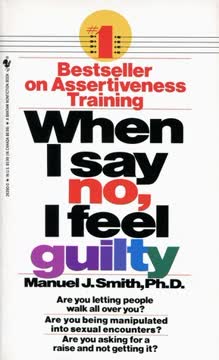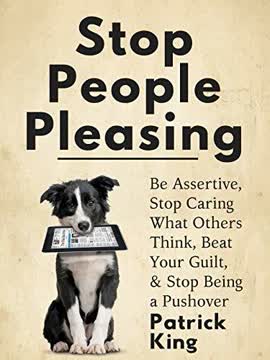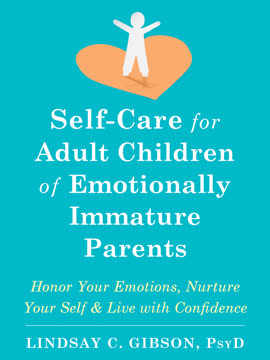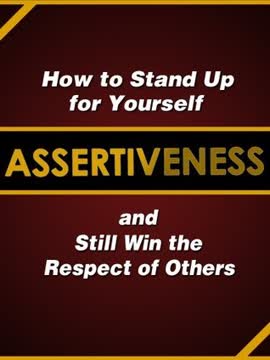Key Takeaways
1. Assertiveness: The Balance Between Passive and Aggressive Communication
Assertiveness is a style of communication that empowers its users to speak out and stand up for themselves in clear, respectful ways.
Defining assertiveness. Assertiveness is the art of expressing one's needs, wants, and opinions confidently while respecting others' rights and feelings. It strikes a balance between passive communication, which neglects one's own needs, and aggressive communication, which disregards others' needs.
Benefits of assertiveness:
- Enhances self-esteem and confidence
- Improves decision-making skills
- Reduces feelings of bitterness and resentment
- Earns respect from others
- Helps navigate conflicts with poise
Misconceptions about assertiveness:
- It's not about being liked by everyone
- It doesn't guarantee getting everything you want
- It's not synonymous with aggressiveness or rudeness
2. Building a Strong Foundation of Self-Worth and Rights
You don't get harmony when everybody sings the same note.
Self-evaluation is crucial. To become assertive, one must first understand their current communication style and self-perception. This involves assessing factors such as eye contact, voice projection, posture, and ability to express opinions or say "no".
Establishing personal rights. The "Bill of Rights" of assertiveness provides a framework for understanding one's inherent rights, including:
- The right to judge one's own behavior and emotions
- The right to offer no reasons or excuses for decisions
- The right to change one's mind
- The right to make mistakes and be responsible for them
- The right to say "I don't know" or "I don't understand"
Positive self-talk. Changing negative internal dialogue to positive affirmations can significantly impact self-perception and assertiveness. Examples include:
- "I am worthy and deserving of respect"
- "I easily express my thoughts, opinions, and desires"
- "I stand up for my rights"
3. Body Language: The Silent Communicator of Confidence
Assertiveness is not what you do, it's who you are!
Nonverbal cues matter. Body language plays a crucial role in how others perceive and respond to us. Key elements of assertive body language include:
- Eye contact: Maintain appropriate eye contact to show engagement and confidence
- Posture: Stand or sit straight with shoulders back to project openness and self-assurance
- Facial expressions: Use genuine smiles and relaxed facial muscles to convey approachability
- Gestures: Use open, calm hand movements to emphasize points without appearing aggressive
Practice makes perfect. Developing assertive body language requires conscious effort and practice. Techniques include:
- Mirror exercises to improve eye contact and facial expressions
- Role-playing scenarios to practice posture and gestures
- Mindfulness of body positioning in daily interactions
4. Verbal Techniques for Effective Assertive Communication
Assertive communication exudes self-control and voices words in a relaxed, respectful manner.
Clear and concise language. Assertive communication relies on direct, simple statements that clearly express needs, wants, or opinions. Key verbal techniques include:
- Basic assertion: Straightforward statements of wants or beliefs
- Empathy assertion: Recognizing others' feelings before stating your position
- Escalating assertion: Becoming increasingly firm while remaining calm
- "I" statements: Focusing on personal feelings and experiences rather than blaming others
Avoiding communication pitfalls:
- Eliminate filler words like "um" or "uh" that undermine confidence
- Steer clear of apologetic language when expressing needs
- Refrain from using aggressive or passive-aggressive tones
5. Assertiveness in Personal Relationships: Setting Boundaries with Love
You teach your partner how to treat you.
Establishing mutual respect. In personal relationships, assertiveness involves setting clear boundaries while maintaining love and respect. This includes:
- Communicating wants and needs openly
- Listening actively to your partner's perspective
- Finding compromise without sacrificing self-respect
Parenting with assertiveness. When dealing with children, assertive communication helps:
- Set clear expectations and consequences
- Model respectful behavior
- Encourage children to express their own needs and feelings appropriately
Handling difficult family dynamics. Assertiveness can help navigate challenging relationships with parents or siblings by:
- Establishing adult-to-adult communication patterns
- Setting boundaries on intrusive or disrespectful behavior
- Expressing love and respect while maintaining personal autonomy
6. Workplace Assertiveness: Navigating Professional Relationships
Only those who dare to fail greatly can ever achieve greatly.
Dealing with difficult colleagues. Assertiveness in the workplace involves:
- Addressing issues directly and privately
- Focusing on specific behaviors rather than personal attacks
- Proposing solutions and setting clear expectations
Asking for a raise assertively:
- Schedule a specific meeting to discuss compensation
- Prepare evidence of your value to the company
- Clearly state your request and desired outcome
- Be open to negotiation and compromise
- Follow up appropriately if an immediate decision isn't made
Handling authority figures. When dealing with bosses or supervisors:
- Maintain respect while expressing your viewpoint
- Focus on mutual goals and benefits to the company
- Use escalating assertion if initial attempts are unsuccessful
7. The Assertive Consumer: Empowered Buying and Problem-Solving
The power is on your side.
Informed purchasing. Assertive consumers:
- Research products and services thoroughly before buying
- Clearly communicate needs and wants to salespeople
- Are willing to negotiate prices and terms
- Feel comfortable walking away from unsatisfactory deals
Resolving product issues. When dealing with faulty products or services:
- Clearly identify and document the problem
- Gather all relevant purchase information and warranties
- Contact the company with a specific request for resolution
- Escalate the issue if necessary, while maintaining respect
- Consider external advocacy groups if the company is unresponsive
Maintaining perspective. Remember that assertiveness doesn't guarantee getting everything you want, but it ensures your voice is heard and respected in consumer interactions.
8. Raising Assertive Children: Equipping the Next Generation
One of the most important things a parent or caring adult can do is model good behavior.
Teaching assertiveness skills. Help children develop assertiveness by:
- Role-playing scenarios involving peer pressure or bullying
- Emphasizing the right to say "no" to uncomfortable situations
- Encouraging clear expression of feelings and needs
Modeling assertive behavior. Children learn by example, so parents should:
- Demonstrate respectful communication in daily interactions
- Handle conflicts assertively in front of children
- Explain thought processes behind assertive decisions
Balancing support and independence. Avoid being a "helicopter parent" by:
- Allowing children to solve age-appropriate problems independently
- Offering guidance when asked, rather than immediately intervening
- Praising efforts to communicate assertively, even if imperfect
9. Transitioning to Assertiveness: Embracing the Learning Curve
It's always too early to quit.
Expect challenges. Becoming assertive is a process that involves:
- Overcoming ingrained habits and fears
- Experiencing setbacks and moments of doubt
- Potentially overcompensating with aggressive behavior initially
Persistence is key. Developing assertiveness requires:
- Consistent practice in various situations
- Patience with oneself during the learning process
- Recognition that progress may not always be linear
Celebrate small victories. Acknowledge improvements in:
- Ability to express needs and wants
- Comfort in setting boundaries
- Reduced anxiety in confrontational situations
Remember that becoming assertive is a journey of self-discovery and growth. With time and practice, assertive communication becomes more natural and integrated into one's personality, leading to more fulfilling personal and professional relationships.
Last updated:
FAQ
What’s "Assertiveness: How to Stand Up for Yourself and Still Win the Respect of Others" by Judy Murphy about?
- Comprehensive Guide to Assertiveness: The book is a practical guide to understanding and developing assertive communication skills in various areas of life, including personal relationships, parenting, the workplace, and consumer situations.
- Distinguishing Assertiveness: It clarifies the differences between assertiveness, aggressiveness, and passiveness, emphasizing respect for oneself and others.
- Step-by-Step Approach: The book provides self-evaluation tools, practical exercises, and real-world scenarios to help readers build confidence and assertive habits.
- Focus on Real-World Application: Rather than just theory, Judy Murphy offers actionable advice and realistic examples for readers to implement assertiveness in everyday situations.
Why should I read "Assertiveness" by Judy Murphy?
- Empowerment and Self-Respect: The book helps readers gain the confidence to express their needs and opinions without guilt or fear, leading to greater self-respect.
- Improved Relationships: By learning assertive communication, readers can foster healthier, more honest relationships at home, work, and in social settings.
- Practical Tools and Exercises: The book offers quizzes, self-talk affirmations, and role-playing exercises to practice and internalize assertive behaviors.
- Realistic and Relatable: Judy Murphy addresses common challenges and myths about assertiveness, making the advice accessible and applicable to real-life situations.
What are the key takeaways from "Assertiveness" by Judy Murphy?
- Assertiveness Is About Respect: Assertiveness means expressing your needs and opinions clearly while respecting others, unlike aggression (disrespect for others) or passivity (disrespect for self).
- Self-Perception Matters: How you see yourself directly impacts your ability to be assertive; building a strong foundation of self-worth is essential.
- Body Language and Voice: Non-verbal cues and tone of voice are crucial in how others perceive and respond to you; confident body language supports assertive communication.
- Practice and Persistence: Becoming assertive is a process that requires practice, patience, and the willingness to make mistakes and learn from them.
How does Judy Murphy define assertiveness, and how is it different from aggressiveness and passiveness?
- Assertiveness Defined: Assertiveness is the confident and respectful expression of your needs, wants, and opinions, while considering the rights and feelings of others.
- Aggressiveness vs. Assertiveness: Aggressiveness disregards others’ rights and often involves shouting, threats, or manipulation, whereas assertiveness seeks compromise and mutual respect.
- Passiveness vs. Assertiveness: Passiveness involves neglecting your own needs and expecting others to guess them, often leading to resentment and unmet needs.
- Balance and Boundaries: Assertiveness strikes a balance—standing up for yourself without infringing on others, and setting clear, healthy boundaries.
What is the "Bill of Rights" of Assertiveness in Judy Murphy’s book, and why is it important?
- Personal Rights Foundation: The "Bill of Rights" is a set of ten personal rights adapted from Manuel J. Smith’s work, serving as a mental framework for assertive behavior.
- Empowerment Tool: These rights remind readers they are worthy of respect, can say no, make mistakes, change their minds, and are not responsible for others’ happiness.
- Boundary Setting: Embracing these rights helps remove guilt, fear, and self-doubt, making it easier to set and maintain boundaries.
- Internal Shift: Regularly affirming these rights fosters a mindset shift from passivity to self-empowerment.
How does "Assertiveness" by Judy Murphy help readers evaluate and improve their self-perception?
- Self-Evaluation Quiz: The book includes a quiz to assess current assertiveness levels, focusing on eye contact, voice, confidence, and ability to say no or express opinions.
- Scenario Analysis: Readers are guided through hypothetical situations to reflect on their typical communication style—assertive, passive, or aggressive.
- Identifying Weaknesses: Honest self-assessment helps pinpoint areas where self-perception may be limiting assertive behavior.
- Building a Strong Foundation: The book offers strategies like positive self-talk and affirmations to replace negative self-perceptions with empowering beliefs.
What practical techniques does Judy Murphy recommend for developing assertive body language and communication?
- Body Language Exercises: The book details exercises for improving eye contact, posture, smiling, and hand gestures to project confidence.
- Voice and Tone: Readers are encouraged to speak clearly, avoid filler words, and use a calm, neutral tone to convey self-assurance.
- Assertive Language Patterns: Four verbal techniques are outlined: basic assertion, empathy statements, escalation (when needed), and “I”/“me” statements to express needs without blame.
- Role-Playing and Practice: Practicing in front of a mirror or with friends/family helps internalize new behaviors before real-life application.
How does "Assertiveness" by Judy Murphy address assertiveness in personal relationships and family dynamics?
- Partner Communication: The book provides steps for expressing needs and setting boundaries with significant others, using “I” statements and empathy.
- Parenting Children: Assertive parenting involves clear, respectful instructions and consequences, fostering mutual respect and responsibility.
- Dealing with Parents: For adult children, the book offers advice on setting boundaries with overbearing or judgmental parents, transitioning to a peer-like relationship.
- Role Reversal and Caregiving: Guidance is given for assertively managing the challenges of caring for aging parents, including asking for help and advocating for their needs.
What strategies does Judy Murphy suggest for being assertive in the workplace?
- Handling Difficult Co-workers: The book provides scripts and approaches for addressing slacking, gossip, or hostility assertively and respectfully.
- Dealing with Bosses: Readers learn how to stand up to disrespectful or aggressive supervisors using calm, direct communication and, if necessary, escalating language.
- Asking for a Raise: A step-by-step process is outlined—preparing evidence, scheduling a meeting, presenting your case assertively, and handling objections or denials.
- Universal Respect: Assertive communication is recommended for all workplace interactions, regardless of hierarchy, emphasizing mutual respect.
How can readers use assertiveness as consumers, according to Judy Murphy?
- Assertive Buying: The book teaches readers to research products, define needs and wants, and negotiate respectfully without succumbing to sales pressure.
- Saying No: Readers are reminded they have the right to walk away from a purchase and not feel guilty for declining a salesperson’s efforts.
- Handling Complaints: Assertive communication is recommended when dealing with faulty products or poor service—being clear, persistent, and respectful while escalating if necessary.
- Documentation and Follow-Up: Keeping records and following up with higher management or advocacy groups is encouraged for unresolved issues.
What advice does "Assertiveness" by Judy Murphy give for raising assertive children?
- Role-Playing Scenarios: Parents are encouraged to practice assertive responses with children, especially for handling peer pressure, bullying, or unsafe situations.
- Modeling Behavior: Children learn assertiveness best by observing their parents’ respectful, clear communication in daily life.
- Teaching the Power of “No”: The book emphasizes teaching children that it’s okay to say no without apology or explanation.
- Avoiding Over-Parenting: Parents are cautioned against “helicopter parenting” and instead are urged to let children solve problems and make mistakes to build confidence.
What are the common challenges and myths about assertiveness discussed in Judy Murphy’s book, and how can readers overcome them?
- Myths Identified: The book addresses myths such as anxiety being a weakness, modesty preventing self-assertion, the “good friend” mind-reading fallacy, obligation to others, gender role expectations, and fear of taking a stand.
- Normalizing Struggles: Readers are reassured that setbacks, overreactions, and initial discomfort are normal parts of the assertiveness journey.
- Practice and Observation: Consistent practice, observing assertive role models, and tackling one challenge at a time are recommended for overcoming barriers.
- Persistence Pays Off: The book emphasizes that assertiveness is a skill developed over time, with progress often being non-linear but ultimately rewarding.
What are the best quotes from "Assertiveness" by Judy Murphy, and what do they mean?
- “Assertiveness is a style of communication that empowers its users to speak out and stand up for themselves in clear, respectful ways.”
- This encapsulates the book’s core message: assertiveness is about empowerment and respect, not dominance or submission.
- “Assertive people are neither submissive nor aggressively dominant. They strike a clear balance of respect for others’ opinions while stating their needs and wants in a way that cannot be misinterpreted.”
- This highlights the importance of balance and clarity in assertive communication.
- “You teach your partner how to treat you, and here’s how to use assertive communication to teach that partner to treat you with love and respect.”
- This quote underscores the proactive role individuals play in shaping their relationships through assertiveness.
- “Assertiveness is not what you do, it’s who you are!” —Shakti Gawain (quoted in the book)
- Assertiveness is presented as an integral part of one’s identity, not just a set of actions.
- “If liberty means anything at all, it means the right to tell people what they do not want to hear.” —George Orwell (quoted in the book)
- This quote reinforces the value of honest, assertive expression, even when it’s uncomfortable for others.
Review Summary
"Assertiveness" is generally well-received, with readers praising its practical advice, clear examples, and concise format. Many found the book helpful for improving communication skills, setting boundaries, and boosting confidence. The "Assertive Person's Bill of Rights" and workplace assertiveness tips were particularly appreciated. Some readers felt the content was basic or repetitive, but most found value in the actionable strategies and exercises provided. The book's straightforward approach and focus on real-world scenarios resonated with many readers seeking to become more assertive in various aspects of their lives.
Similar Books










Download PDF
Download EPUB
.epub digital book format is ideal for reading ebooks on phones, tablets, and e-readers.





